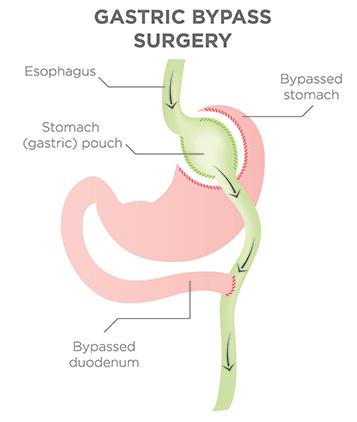Roux En Y Gastric Bypass
Roux en y gastric bypass surgery is an increasingly popular form of weight-loss surgery that promotes weight loss by restricting how much food can be eaten at one sitting and limiting nutrient absorption. It is the most frequently performed bariatric procedure.
Most gastric bypass surgeries performed today utilize laparoscopic techniques, resulting in minimal blood loss and faster recoveries.
Roux-en-Y is a type of bariatric surgery
Roux-en-Y gastric bypass surgery is an innovative form of weight loss surgery which reroutes your digestive system in order to help you shed unwanted pounds. It creates a small pouch in your stomach which connects directly with the small intestine, thus bypassing part of your stomach and duodenum and decreasing caloric and nutritional absorption; making this combination restrictive/malabsorptive method of weight loss the most successful surgical weight reduction method currently available.
Your surgeon will make several tiny incisions in your abdomen, each about half an inch in size. He’ll insert long, narrow instruments through these openings in order to perform laparoscopy – an innovative, minimally-invasive alternative to open surgery.
Health insurance plans typically cover gastric bypass surgery if you meet certain qualifications, including having a body mass index (BMI) of 30 or higher and receiving a diagnosis of obesity or another obesity-related health condition from your physician. Prior to considering surgery, your doctor may ask that diet and exercise changes are made first before making this decision.
It involves making a small pouch
Under general anesthesia and painlessly, this surgery entails the division and creation of a small egg-sized pouch at the top of your stomach to limit how much food can enter. Once created, this pouch will then be connected directly to part of your small intestine bypassing much of your stomach and duodenum which helps reduce fat absorption.
Laparoscopic surgery means you won’t need to make large incisions; therefore, healing faster with less scars.
Roux-en-Y gastric bypass surgery restructures your digestive tract to form the shape of a “Y.” To create this pouch, surgical staples separate the upper portion of your stomach from its lower portion; food passes directly from this pouch into a portion of small bowel located slightly lower down, helping you lose weight by decreasing calorie and nutrition absorption in your stomach and duodenum.
It reduces the amount of food that a person can eat at one time
Roux-en-Y gastric bypass surgery is a two-step procedure designed to reduce stomach size and redirect intestines for weight loss, one of many bariatric procedures offered at UT Southwestern Medical Center. On average, patients achieve 50% weight loss up to 15 years following this surgery.
At the outset of surgery, your surgeon will create a small pouch in your stomach by stapling. This limits how much food can be eaten at once, before connecting this pouch with an area of the small intestine – thus bypassing a significant portion of both stomach and duodenum which reduces fat absorption.
After your procedure, you will gradually increase your food intake as your stomach and intestines heal. Vitamin supplements will likely become necessary since your digestive tract won’t absorb iron, calcium and vitamin B12 as efficiently.
It makes a person feel full more quickly
Roux-en-Y Gastric Bypass (RYGB) surgery involves surgically shrinking your stomach size and changing how food travels through your digestive tract. It is both restrictive and malabsorptive, meaning you’ll eat less while losing more weight – an effective strategy for treating morbid obesity as well as associated conditions, such as diabetes, high blood pressure, fatty liver disease and sleep apnea.
A surgeon creates a small stomach pouch and connects it to a lower portion of your small intestine, or “Roux limb.” This reduces storage capacity in your stomach and can help you feel satisfied after only eating small meals. Furthermore, this procedure alters gut hormones such as elevated peptide YY and glucagon-like peptide 1 which help control appetite.
After your surgery, your stomach and intestine may require some restorative measures for healing to take place. Gradually introduce soft foods into your diet before gradually adding solid foods back in. You will require vitamin supplements including iron, calcium and B12.
Disclaimer: The content on this blog is intended for general informational purposes only. It is not a substitute for professional medical advice, diagnosis, or treatment. Always consult qualified healthcare providers for personalized advice. Information regarding plastic surgery, dental treatment, hair transplant, and other medical procedures is educational and not a guarantee of results. We do not assume liability for actions taken based on blog content. Medical knowledge evolves; verify information and consult professionals. External links do not imply endorsement. By using this blog, you agree to these terms.










